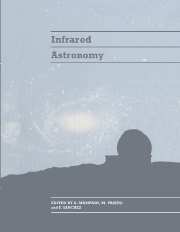Book contents
- Frontmatter
- Contents
- List of Participants
- Preface
- 1 Star Formation
- 2 Last Stages of Stellar Evolution
- 3 The Milky Way Galaxy and the Galactic Centre
- 4 Galaxies in the Infrared
- 5 Cosmology
- 6 G25.2+0.2, a New Ring Nebula Around a Luminous Blue Star: Case Study for the Importance of IR Observations
- 7 Two Colloquia on Cosmic Dust
- 8 Infrared Instrumentation
- 9 Infrared Astronomy with Satellites
1 - Star Formation
Published online by Cambridge University Press: 23 December 2009
- Frontmatter
- Contents
- List of Participants
- Preface
- 1 Star Formation
- 2 Last Stages of Stellar Evolution
- 3 The Milky Way Galaxy and the Galactic Centre
- 4 Galaxies in the Infrared
- 5 Cosmology
- 6 G25.2+0.2, a New Ring Nebula Around a Luminous Blue Star: Case Study for the Importance of IR Observations
- 7 Two Colloquia on Cosmic Dust
- 8 Infrared Instrumentation
- 9 Infrared Astronomy with Satellites
Summary
…per aspera ad astra
INFRARED ASTRONOMY AND STAR FORMATION
In a report of the current status of the observational studies of star formation published in 1982, Wynn-Williams introduced the subject by boldly stating “Protostars are the Holy Grail of infrared astronomy”, one of the most (ab)used astronomical quotations ever. At the time of the review, searches had been made at IR wavelengths towards a restricted sample of objects, guided by the theoretical expectation that protostars would undergo a phase of high IR luminosity during the main accretion phase (Larson 1969). The aim of these studies, and of those that followed, was to get an unambiguous example of Spitzer's definition (1948) of a protostar as “an isolated interstellar cloud undergoing inexorable gravitational contraction to form a single star”.
This definition appears now rather restrictive, since observations have shown that the structure of star forming regions is highly complex, rarely revealing well isolated, noninteracting interstellar clouds. In addition, observations in the near infrared at high spatial resolution have shown that many young stars are not single, but do have companions (Zinnecker & Wilking 1992). However, despite great effort, resulting from improvements in instrumentation and progress in the theoretical models, the same discouraging conclusion reached by Winn-Williams in 1982 still holds true: no conclusive identification of a genuine protostar has yet been made. Nevertheless, the motivation for continuing the search using the IR band remains still unquestionable.
In these lectures I will present an overview of the main properties of the star formation process with a special emphasis on stars of low- and intermediate-mass, for which observations are the most detailed and a consistent theoretical framework has been developed and tested.
- Type
- Chapter
- Information
- Infrared Astronomy , pp. 1 - 62Publisher: Cambridge University PressPrint publication year: 1994
- 1
- Cited by

